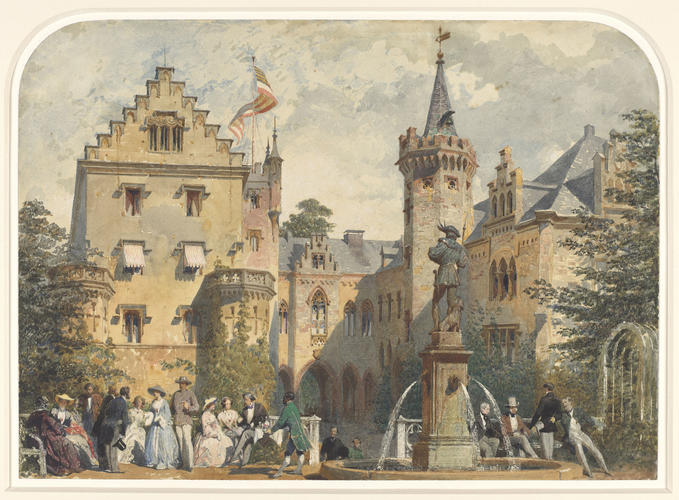The terrace, Schloss Reinhardsbrunn c.1854
Pencil, watercolour and bodycolour with scraping out | 25.4 x 35.3 cm (whole object) | RCIN 917552
-
A watercolour depicting a view of the terrace at the hunting castle of Reinhardsbrunn, with Duke Ernest II and his entourage seated in the foreground. With curved top corners; the remains of a signature has been cut off.
The Castle of Reinhardsbrunn was built by Prince Albert's father, Duke Ernest I of Saxe-Coburg and Gotha (1784-1844); the Duke's architect Gustavus Eberhard transformed what was a ruined Benedictine Abbey into a Gothic hunting seat. Some twenty years later, in 1845, the prince and his wife Queen Victoria visited Germany together for the first time, spending the majority of their trip in the region where Albert grew up. The queen was delighted with Schloss Reinhardsbrunn, describing it in her journal as ‘a lovely place & the house beautifully & tastefully furnished in dear Papa's [meaning her father-in-law, the Duke's] best taste’ (Queen Victoria's Journal, 27th August 1845). This scene may well be based on Haag’s observations of genteel gatherings of the court of Albert's brother Ernest II, Duke of Saxe-Coburg and Gotha and his wife Alexandrine on summer days.
The most prominent figure in the composition is the Black servant in the foreground, seen in profile holding a tray of drinks. Generic Black figures were often incorporated into compositions to represent the ‘exotic’, and/or to underscore visual messages about the wealth and authority of the primary sitters; but the servant in Haag’s watercolour may be an identifiable individual. After her first visit to Albert’s homeland, Queen Victoria commented in her draft journal on his brother’s servants, who she considered all ‘such good, active, attached people – & … so civil.’ She singled out ‘Philips’, who she described as ‘one poor Black, a handsome tall man … who poor Papa [her father-in-law] took already 4 years ago, who was so attentive to us, & generally drove out with us.’ This was presumably Maximilian Leon Wilhelm Philipps (1811/14-79), who is listed as a ducal servant in the Staathandsbuch für die Herzogthümer Sachsen-Coburg und Gotha for 1847, 1854 and 1865. Accounts of Philipps’s earlier biography differ, but a death notice printed in the Coburger Zeitung on 24 November 1879 (two days after Philipps’s death), stating that Philipps entered ducal service under Ernest I (c.1841, if Queen Victoria's comment cited above is accurate), claimed that it was a well-known fact that the Duke encountered Philipps when the latter was in Coburg with a travelling menagerie, and that Philipps was the menagerie owner’s assistant. According to Queen Victoria’s Lady in Waiting Charlotte Canning, Philipps is also included in an oil painting by Raden Saleh, a Javanese painter resident in Coburg in 1844, which depicts Ernest returning from a hunt and greeting Alexandrine on another terrace, that of Schloss Rosenau. Charlotte Canning saw Raden Saleh's painting when she accompanied Victoria and Albert to Coburg in 1845. Additionally, the Stiftung Schloss Friedenstein Gotha holds a sensitive head study of Philipps (inv. no. SG1396) by Paul Emil Jacobs, court painter to Ernest I, which the artist documented in his diary painting in late February 1842.
Notwithstanding the fact that this is likely a portrait of a real individual, and that Ernest perhaps specified his inclusion, several factors suggest that Philipps has been objectified to serve as an ‘exotic’ focal point in the composition. Aside from his central placement and the dynamic pose of his outstretched leg, he is also the most finished of all the figures in the watercolour – the deep green of the livery he wears has been accentuated by a heavy use of bodycolour. That he proffers the tray of drinks to the group including Ernest and Alexandrine also denotes hierarchy and subordinance.
Carl Haag was born in Bavaria and visited London in 1847 to learn more about English watercolour painting technique, studying at the Royal Academy Schools the following year and settling in England. On a sketching trip in the Tyrol in 1852 he had a chance encounter with Charles, Prince of Leiningen (Queen Victoria’s half-brother) and Albert's brother Ernest II, Duke of Saxe-Coburg and Gotha, who jointly commissioned Haag to paint them in an Alpine setting as a Christmas present for Queen Victoria (see RCIN 917108). Victoria and Albert, impressed with the double portrait, then invited the artist to their residence in the Scottish Highlands, Balmoral Castle, the following autumn, to paint scenes of their lives there. Haag's association with the British court endured for a time after Albert's death in 1861, and there is a significant corpus of watercolours by him in the Royal Collection (including several Egyptian subjects, as Haag spent two years in Egypt and the Near East in 1858-60 and travelled again to Egypt 1873-4). In 1854 Haag was appointed court painter to Ernest II, whose seat Reinhardsbrunn was.Provenance
Purchased from Walker Galleries, 1947 as from the collection of Princess Louise, Duchess of Argyll
-
Creator(s)
-
Medium and techniques
Pencil, watercolour and bodycolour with scraping out
Measurements
25.4 x 35.3 cm (whole object)
Other number(s)
RL 17552








